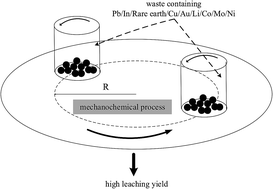Application of mechanochemistry to metal recovery from second-hand resources: a technical overview
Abstract
In the context of huge imbalance between increasing demand for metals and the finiteness of metal resources in nature, recycling metal from second-hand resources, especially e-waste, is of great importance, to embrace the sustainability challenge. Inspired by its hundreds of uses in extractive metallurgy, mechanochemistry has been introduced to recover metals from waste since the 1990s. The mechanochemical recycling process is technically feasible to recover metals from waste in a high yield, such as Pb recovery from cathode ray tube (CRT) funnel glass, Li and Co recovery from lithium-ion batteries, rare earth recovery from fluorescent lamps. In recovery from LCD screens, Cu recovery from waste printed circuit boards and Au, Mo and Ni recovery from waste. Particle size reduction, specific surface area increase, crystalline structure decomposition and bond breakage have been identified as the main changes induced by the mechanochemical processes in the studies. Also, the activation energy required decreases and reaction activity increases, subsequently. This paper presents a technical overview of the applications of mechanochemistry to metal recycling from waste. The current application pattern, reaction mechanisms, equipment used, method procedures, and the future research direction are discussed in detail. This work presents the limitation of current mechanochemical application in metal recovery and gives a perspective of the future development of mechanochemistry as well.

- This article is part of the themed collection: Waste and Recycling: Sources and Resources

 Please wait while we load your content...
Please wait while we load your content...